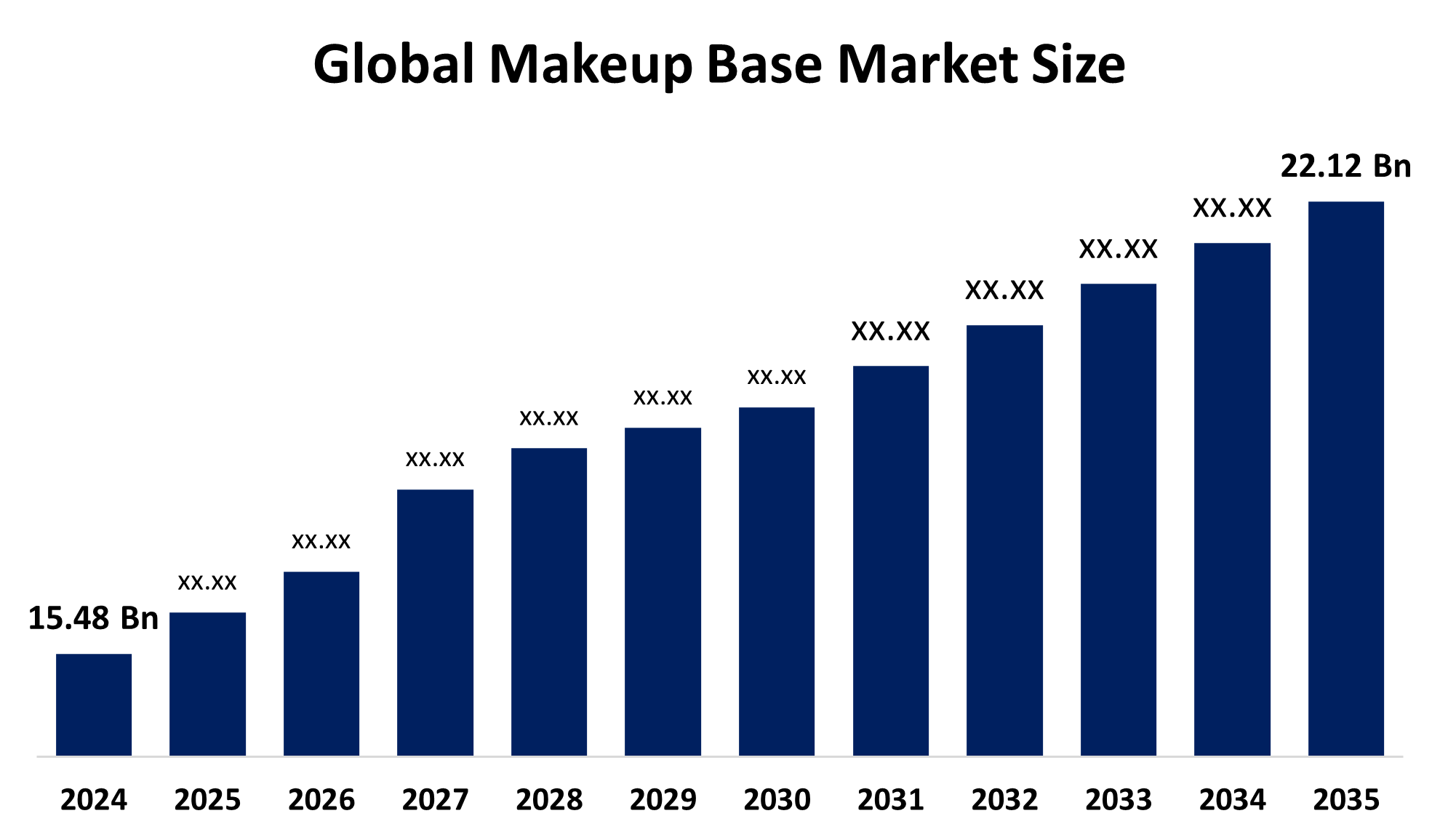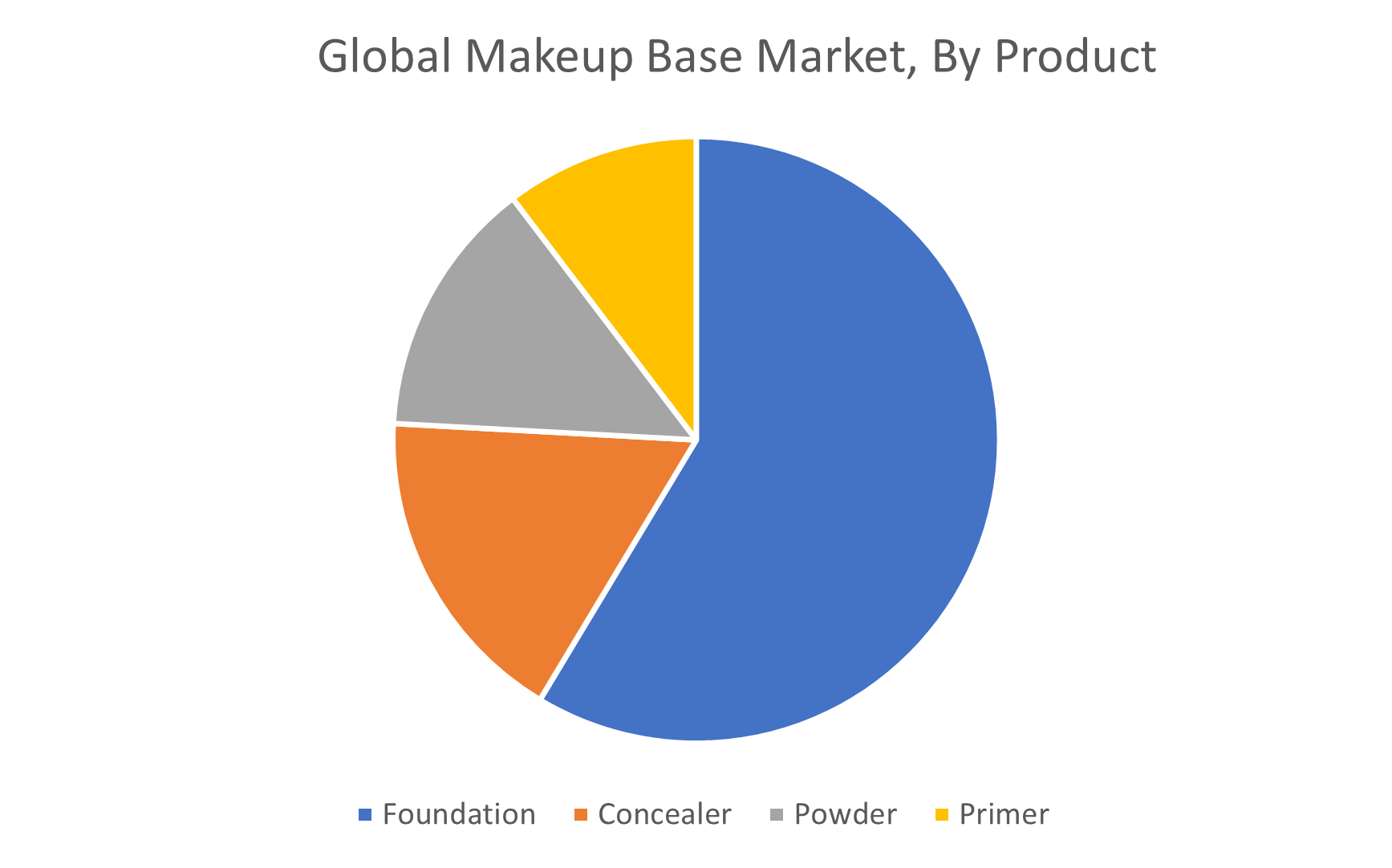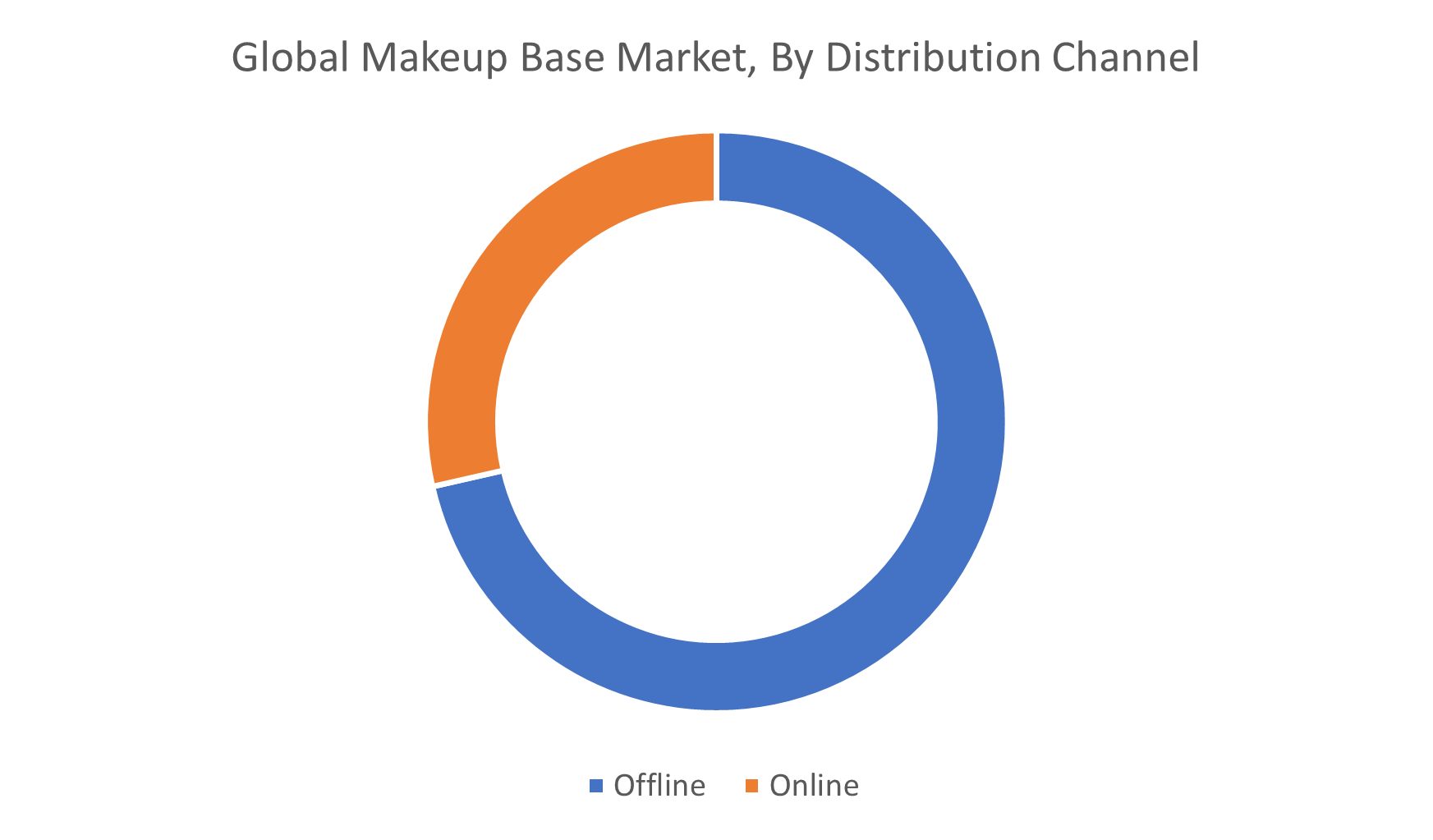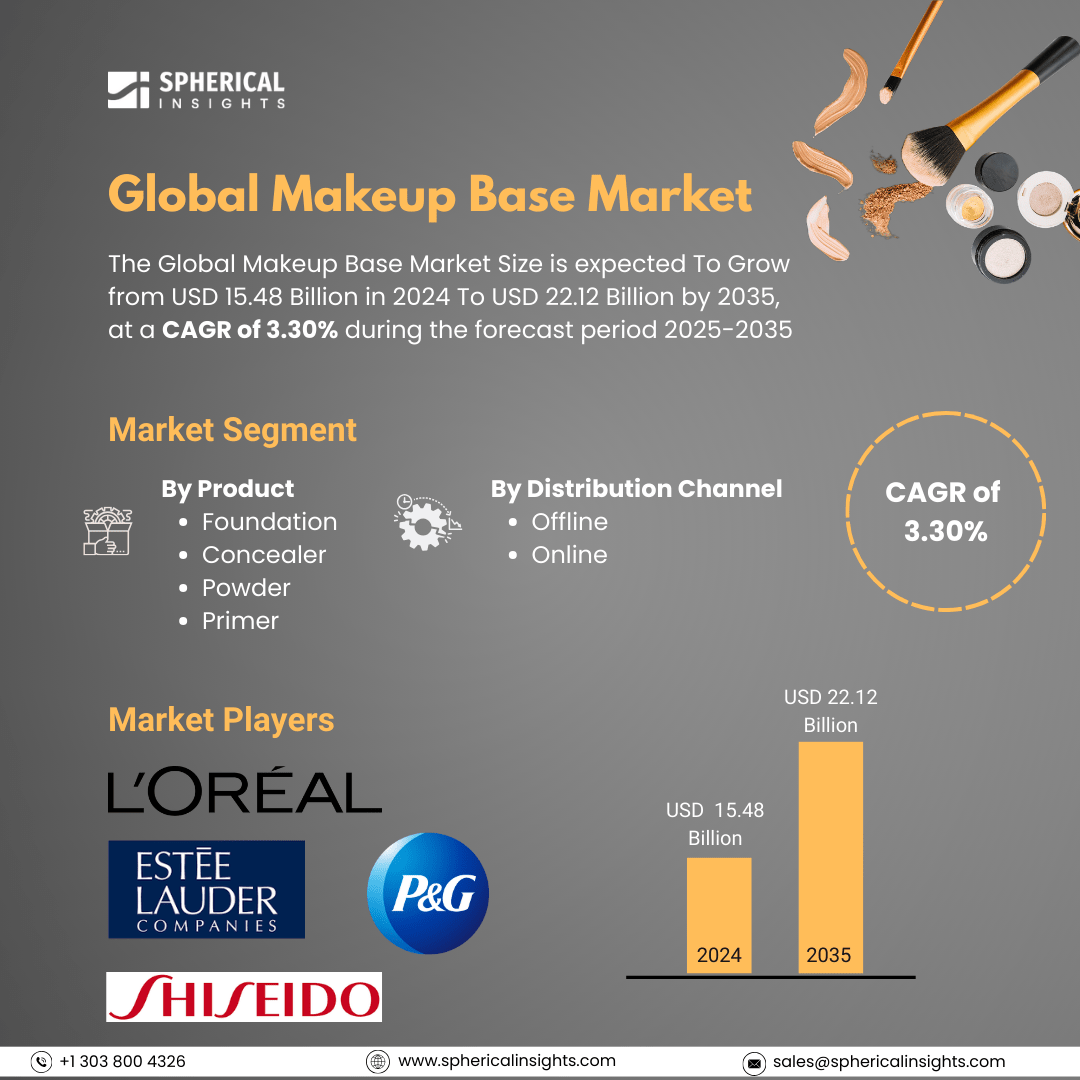Global Makeup Base Market Insights Forecasts To 2035
- The Global Makeup Base Market Size Was Estimated at USD 15.48 Billion in 2024
- The Market Size is Expected to Grow at a CAGR of around 3.30% from 2025 To 2035
- The Worldwide Makeup Base Market Size is Expected to Reach USD 22.12 Billion by 2035
- North America is expected to grow the fastest during the forecast period.

Makeup Base Market
The global makeup base market includes products designed to create a smooth, even complexion as a foundation for further makeup application. This category features foundations, primers, concealers, BB creams, and color-correcting products that help even out skin tone, minimize imperfections, and ensure makeup adheres effectively. Makeup bases are available in a variety of formulations such as liquids, powders, and creams, catering to different skin types and preferences. Consumers increasingly seek products that not only provide coverage but also offer added skincare benefits like hydration, sun protection, and long-lasting wear. The market is driven by a growing awareness of beauty and the desire for high-quality, multifunctional products that meet diverse skincare needs. As the demand for inclusive beauty solutions rises, makeup base products are being developed in a wider range of shades and formulations to accommodate all skin tones and types.
Attractive Opportunities in the Makeup Base Market
- Rising demand for products that cater to diverse skin tones and types is creating opportunities for brands to develop inclusive shade ranges and customized foundation options, enhancing consumer satisfaction and expanding their market reach.
- Consumers increasingly prefer makeup bases that offer skincare benefits like SPF protection, hydration, and anti-aging. This trend supports the growth of hybrid products such as BB creams and serum foundations that combine beauty and skincare.
Global Makeup Base Market Dynamics
DRIVER: Growing trend towards inclusivity in beauty has prompted brands
Increasing beauty awareness, fueled by social media influencers and celebrity endorsements, has led to a higher demand for cosmetics that promise flawless skin. As consumers become more knowledgeable about makeup and skincare, they seek products that not only enhance their appearance but also offer added skincare benefits like hydration, sun protection, and anti-aging properties. Additionally, the growing trend towards inclusivity in beauty has prompted brands to expand their product ranges to cater to all skin tones, leading to a broader customer base. The rise of multi-functional products, such as BB creams and primers with skincare properties, is also gaining traction. Furthermore, the shift towards clean and sustainable beauty is influencing the development of eco-friendly, vegan, and cruelty-free makeup bases. These factors collectively contribute to the expansion and evolution of the makeup base market across the globe.
RESTRAINT: Premium pricing of high-quality products
One significant restraint is the premium pricing of high-quality products, which can make them inaccessible to budget-conscious consumers. This creates a divide between luxury and mass-market products, limiting the reach of some brands. Additionally, the formulation of makeup bases often involves ingredients that may cause skin sensitivities, leading to reluctance among consumers with sensitive skin to experiment with new products. The proliferation of counterfeit makeup products, especially in markets with lax regulations, also poses a risk to both consumers and established brands. Moreover, volatile raw material costs, particularly for specialized pigments and natural extracts, can drive up production expenses, affecting the pricing structure. Lastly, environmental concerns around excessive packaging and waste in the beauty industry are increasingly influencing consumer purchasing decisions, with many opting for sustainable and eco-conscious alternatives over conventional options.
OPPORTUNITY: Increasing demand for personalized products
The global makeup base market has several new opportunities beyond traditional growth factors. There’s increasing demand for personalized products, such as foundations that cater to individual skin tones and needs, allowing brands to create tailored solutions. The men’s grooming market is also expanding, with more men exploring makeup products, offering brands a new customer base. Additionally, there’s a rising interest in innovative and eco-friendly packaging, which appeals to consumers who prioritize sustainability. The trend towards multifunctional products, like primers that provide skincare benefits, also offers growth potential. Lastly, emerging markets in developing regions present significant opportunities as disposable incomes rise and beauty awareness grows, leading to a boost in makeup base product consumption. These factors open doors for brands to tap into new segments and innovate within the market.
CHALLENGES: Consumer loyalty poses a hurdle
One major challenge is the saturation of the market, where numerous brands offer similar products, making it difficult for new or smaller players to stand out. Consumer loyalty also poses a hurdle, as many customers prefer trusted, established brands, limiting opportunities for emerging competitors. Moreover, the rise of DIY beauty trends and minimalist routines has reduced the reliance on heavy makeup bases, impacting sales. Another significant challenge is the growing demand for inclusive shades and formulations that cater to diverse skin tones and types, which requires extensive R&D and can delay product launches. Additionally, counterfeit makeup products circulating online damage brand reputation and consumer trust. Finally, adapting to rapidly changing beauty trends on social media and maintaining relevance with younger audiences requires constant innovation and marketing investments.
Global Makeup Base Market Ecosystem Analysis
The global makeup base market ecosystem consists of several key components working together to deliver products to consumers. At the core are raw material suppliers, providing ingredients like pigments, emulsifiers, and moisturizers. These are used by manufacturers and formulators, who develop different types of makeup bases such as primers, foundations, and BB/CC creams. Packaging companies support the industry by offering functional and aesthetic packaging solutions. Distributors and retailers, including online platforms, supermarkets, beauty stores, and specialty outlets, bridge the gap between producers and consumers. Regulatory bodies ensure product safety and compliance with health standards. Influencers, beauty bloggers, and marketing agencies also play a vital role in shaping consumer preferences. Finally, end-users, including individuals and professional makeup artists, complete the ecosystem by driving demand and feedback, influencing future product development.
Based on the product, the foundation segment dominated the makeup base market with the largest revenue share over the forecast period

The segment dominance is attributed to the widespread use of foundation as a core cosmetic product that helps even out skin tone, cover imperfections, and create a smooth base for additional makeup. Foundations are available in various forms such as liquid, powder, cream, and stick, catering to different skin types and preferences. The increasing demand for long-lasting, lightweight, and skin-friendly formulations has further fueled growth in this segment. Additionally, the rise in consumer awareness regarding appearance, along with the expansion of product ranges offering inclusive shades for all skin tones, has contributed significantly to the segment’s strong market position.
Based on the distribution channel, the offline segment dominated the makeup base market with the largest revenue share over the forecast period

The offline segment dominated the global makeup base market with the largest revenue share over the forecast period. This is primarily due to the strong consumer preference for purchasing cosmetics in physical stores, where they can test products, seek expert advice, and compare shades and textures in real-time. Department stores, specialty beauty retailers, and supermarkets have remained popular destinations for makeup purchases. These outlets often provide personalized services, promotional offers, and in-store consultations, which enhance the overall shopping experience. Additionally, offline channels offer immediate product availability, which is especially appealing for last-minute or impulse buyers. The trusted environment and opportunity for physical interaction with products have helped the offline segment maintain its dominance, despite the growing presence of e-commerce platforms.
Asia Pacific is anticipated to hold the largest market share of the makeup base market during the forecast period
Asia Pacific is anticipated to hold the largest market share of the makeup base market during the forecast period. This growth is driven by a combination of factors, including a large and youthful population, increasing urbanization, rising disposable incomes, and growing awareness of beauty and skincare. Countries like China, Japan, South Korea, and India are witnessing a surge in demand for cosmetic products due to evolving beauty standards and the influence of global and local beauty trends. Additionally, the popularity of K-beauty and J-beauty has significantly shaped consumer preferences, boosting demand for innovative and skin-friendly makeup base products. The presence of both international and strong domestic brands, along with expanding retail infrastructure and digital marketing, further supports the region’s dominance in the market.
North America is expected to grow at the fastest CAGR in the makeup base market during the forecast period
North America is expected to grow at the fastest CAGR in the makeup base market during the forecast period. This growth is fueled by increasing consumer interest in high-quality and multifunctional beauty products, such as foundations with skincare benefits or SPF protection. The region has a strong presence of leading cosmetic brands that continuously innovate to meet changing consumer preferences. Additionally, the rise of clean beauty trends and demand for inclusive shade ranges have driven product development and attracted a wider customer base. The popularity of social media influencers, beauty bloggers, and celebrity endorsements also significantly boosts product visibility and consumer engagement. Furthermore, the growing adoption of online shopping platforms, combined with frequent product launches and personalized beauty solutions, contributes to the rapid market expansion in North America.
Recent Development
- In July 2024, Benefit Cosmetics launched its Super Brand Day on TikTok. The event featured exclusive Porefessional Power Powder and Porefessional Matte Primer releases. It included new product bundles such as the Fan Fest Mascara Set and the Benetint Jelly Donut Set. Daily live shopping shows, exclusive deals, and a surprise gift with purchases over USD 40 were offered.
- In January 2024, Makeup Revolution launched two innovative complexion products: the Bright Light Face Glow and the Skin Silk Serum Foundation, available at Ulta and Target. This next-generation foundation offers a radiant satin finish that is weightless and has light-to-medium coverage, enhancing the skin's natural glow.
Key Market Players
KEY PLAYERS IN THE MAKEUP BASE MARKET INCLUDE
- L'Oréal S.A.
- The Estée Lauder Companies Inc.
- Procter & Gamble Co.
- Shiseido Company, Limited
- Unilever plc
- Coty Inc.
- Revlon, Inc.
- Amorepacific Corporation
- Kose Corporation
- Beiersdorf AG
- Others
Market Segment
This study forecasts revenue at global, regional, and country levels from 2020 to 2035. Spherical Insights has segmented the makeup base market based on the below-mentioned segments:
Global Makeup Base Market, By Product
- Foundation
- Concealer
- Powder
- Primer
Global Makeup Base Market, By Distribution Channel
Global Makeup Base Market, By Regional Analysis
- North America
- Europe
- Germany
- UK
- France
- Italy
- Spain
- Russia
- Rest of Europe
- Asia Pacific
- China
- Japan
- India
- South Korea
- Australia
- Rest of Asia Pacific
- South America
- Brazil
- Argentina
- Rest of South America
- Middle East & Africa
- UAE
- Saudi Arabia
- Qatar
- South Africa
- Rest of the Middle East & Africa






